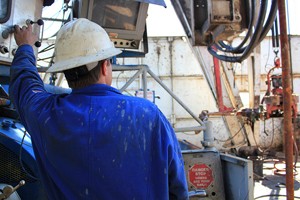Energy, utilities and mining operations pervade American life. The reporter at a medium or small-sized daily should have no trouble localizing global trends and understanding how the local tentacles of these far-reaching sectors affect his or her community.
Here are some story lines that could yield lots of local news:
THE GREAT AMERICAN ENERGY REAWAKENING
The rediscovery of North America by large energy companies is a boon for local reporters. Once thought to be in rapid decline, the oil industry in the U.S. has been revived by two technologies: deepwater drilling and hydraulic fracturing. These techniques, in combination with tougher governments in oil-rich nations, mean that the giant oil companies that once scoured the globe are looking for riches in your own backyard.
The consequences are enormous-fiscally, because the local governments get more tax revenue; economically, because there are more jobs around; and environmentally, because mishaps do happen. The way of life in communities from Pittsburgh to the U.S./Mexico border, passing by North Dakota, is being transformed by this revolution, and local reporters will be the first chroniclers of the change. As we saw during the BP oil spill of 2010, deepwater drilling is having a major impact on life in the Gulf Coast. Not only it underpins the economy there, but it can also represent a danger. And there are many other places where offshore drilling might happen one day—the Eastern and Western coasts, and Alaska, for example.
New fields whose exploitation is made possible by hydraulic fracturing, or fracking, have literally brought the energy industry home to many regions in the U.S that are unaccustomed to this kind of activity. For example, large swaths of the U.S. Northeast – New York, Ohio, New Jersey and Pennsylvania – sit below a rich natural gas field
called the Marcellus shale, and there’s drilling going on under local churches, schools, airports and cemeteries. Since this is a new energy-producing area, reporters are playing a key role enlightening the local audience about what has turned out to be a controversial development. Familiarize yourself with leases, royalties, the science of fracking—and with the natural gas companies setting up shop next door.
A JUNGLE OF INFRASTRUCTURE: REFINERIES, POWER PLANTS, NUCLEAR PLANTS, PIPELINES, MINES
Wherever you are in the U.S., it’s likely that you’re close to a refining hub – and that natural gas and oil pipelines are buried nearby. If you are, say, in Seattle, get to know the Anacortes refineries—and be ready to know that if there’s any disruption to the Alaska oil they process, local gas prices are likely to rise. Also know their safety stats and be ready to report on fires, harmful gas emissions and other accidents that can occur in these facilities.
Likewise, know thy local power provider(s) – and the state regulator that normally oversees power price changes. Check what their power mix is—how much hydro-electric, how much wind, how much coal, how much nuclear and how much natural gas. Track the price of these commodities– they’re indicators of whether power prices will go up or down. Many utilities across the country are having a hard time keeping up with growth projections—figure out how much they’re investing in new power generation, and of what kind.
Know the pipelines in your region – see what water bodies they cross, what refineries or areas they serve, so you can be ready to roll in case news breaks. Keep an eye on the national news—right now, for example, there’s a major controversy on whether to approve a gigantic pipeline expansion called Keystone XL, which would bring crude from Canada all the way to the Gulf Coast. That crosses many states—perhaps the one you live in.
If you’re in Arizona, Kentucky or West Virginia, it’s likely that you’ll be close to a mining culture— follow the big picture evolution of copper prices, for example, or demand for coal, to anticipate swings in local fortunes.
DEVELOP RELATIONSHIPS
Most refiners, energy companies, utilities and pipeline operators have local spokespeople – know who they are and have them show you around.Identifying and knowing these actors helps get information more quickly when a crisis breaks.










